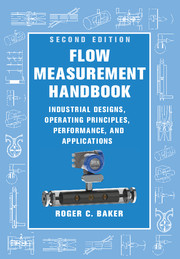Book contents
- Frontmatter
- Dedication
- Contents
- Preface
- Acknowledgements
- Nomenclature
- 1 Introduction
- 2 Fluid Mechanics Essentials
- 3 Specification, Selection and Audit
- 4 Calibration
- 5 Orifice Plate Meters
- 6 Venturi Meter and Standard Nozzles
- 7 Critical Flow Venturi Nozzle
- 8 Other Momentum-Sensing Meters
- 9 Positive Displacement Flowmeters
- 10 Turbine and Related Flowmeters
- 11 Vortex Shedding, Swirl and Fluidic Flowmeters
- 12 Electromagnetic Flowmeters
- 13 Magnetic Resonance Flowmeters
- 14 Ultrasonic Flowmeters
- 15 Acoustic and Sonar Flowmeters
- 16 Mass Flow Measurement Using Multiple Sensors for Single-Phase Flows
- 17 Multiphase Flowmeters 508
- 18 Thermal Flowmeters
- 19 Angular Momentum Devices
- 20 Coriolis Flowmeters
- 21 Probes for Local Velocity Measurement in Liquids and Gases
- 22 Verification and In Situ Methods for Checking Calibration
- 23 Remote Data Access Systems
- 24 Final Considerations
- References
- Main Index
- Flowmeter Index
- Flowmeter Application Index
15 - Acoustic and Sonar Flowmeters
Published online by Cambridge University Press: 05 August 2016
- Frontmatter
- Dedication
- Contents
- Preface
- Acknowledgements
- Nomenclature
- 1 Introduction
- 2 Fluid Mechanics Essentials
- 3 Specification, Selection and Audit
- 4 Calibration
- 5 Orifice Plate Meters
- 6 Venturi Meter and Standard Nozzles
- 7 Critical Flow Venturi Nozzle
- 8 Other Momentum-Sensing Meters
- 9 Positive Displacement Flowmeters
- 10 Turbine and Related Flowmeters
- 11 Vortex Shedding, Swirl and Fluidic Flowmeters
- 12 Electromagnetic Flowmeters
- 13 Magnetic Resonance Flowmeters
- 14 Ultrasonic Flowmeters
- 15 Acoustic and Sonar Flowmeters
- 16 Mass Flow Measurement Using Multiple Sensors for Single-Phase Flows
- 17 Multiphase Flowmeters 508
- 18 Thermal Flowmeters
- 19 Angular Momentum Devices
- 20 Coriolis Flowmeters
- 21 Probes for Local Velocity Measurement in Liquids and Gases
- 22 Verification and In Situ Methods for Checking Calibration
- 23 Remote Data Access Systems
- 24 Final Considerations
- References
- Main Index
- Flowmeter Index
- Flowmeter Application Index
Summary
Introduction
I have introduced this new chapter to cover two new flowmeters using sonar principles, those produced by CiDRA and those produced by Expro. In addition I have briefly covered related ideas and, in particular, acoustic chemometrics, and other applications of noise in flow systems.
Since preparing the 1st Edition of this Handbook, CiDRA's SONARtrac® flowmeter has become a significant additional meter making use of methods not previously developed to this author's knowledge, and finding an important application in minerals processing and other industrial flow measurement needs. I became aware of the instrument from an acquaintance who had experienced tests of the meter at SP, Sweden. This chapter provides a summary of the information available, virtually all of which comes from publications provided by CiDRA and from Expro Meters Inc. While SONARtrac® is described as passive sonar, the meter developed by Expro is described as active sonar. We shall discuss this further in Section 15.3.
My knowledge of this meter is, therefore, almost entirely dependent on the manufacturers, as I am unaware of any published data which is entirely independent of them, except for two Test Reports: T 1917 X 10 November 2010 (SP Technical Research Institute, Sweden) and T 1883 X 08 February 2008 (Alden Research Laboratory Inc) published by Evaluation International.
SONARtrac® Flowmeter
Basic Explanation of How the Passive Sonar Flowmeter Works
Sonar array-based flowmeters operate by using an array of sensors and passive sonar processing algorithms to detect, track and measure the mean velocities of coherent disturbances travelling in the axial direction of a pipe (O'Keefe, Maron and Rothman 2009a). These meters are primarily “clamp-on” meters.
These disturbances are grouped into three major categories:
1) disturbances conveyed by the flow;
2) acoustic waves in the fluid;
3) vibrations transmitted by the pipe walls.
Each disturbance class travels at a given velocity. For example, the flow will convey turbulent eddies, density variations or other fluid characteristics at the rate of the fluid flow. Liquid-based flows in pipes tend to be less than 10 m/s. The speed of sound (acoustic wave velocity) in water without gas bubbles is about 1,500 m/s.
- Type
- Chapter
- Information
- Flow Measurement HandbookIndustrial Designs, Operating Principles, Performance, and Applications, pp. 484 - 500Publisher: Cambridge University PressPrint publication year: 2016



